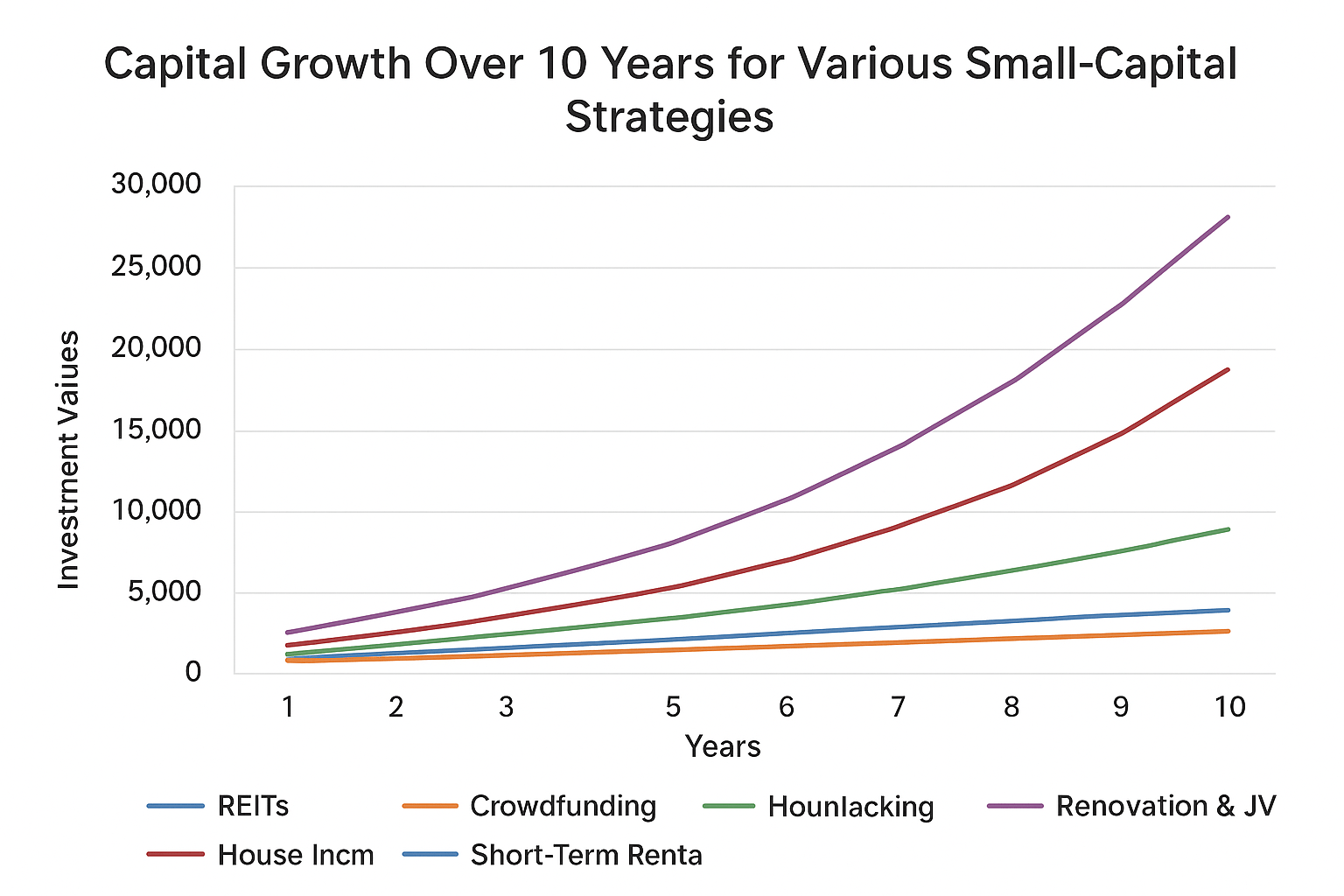How to Start Investing in Real Estate with Little Capital
August 14, 2025
Introduction
Investing in real estate is often seen as a pathway to financial freedom and wealth building. Yet, many aspiring investors believe they need large sums of money to get started. The truth is, real estate investing with little capital is not only possible but increasingly accessible, thanks to modern tools, financial products, and creative strategies.
Whether you want to generate passive income, grow equity, or flip properties, starting small can be your first step to long-term financial success. This guide is a comprehensive roadmap for anyone ready to invest in property with limited funds, with global relevance and strategies adaptable to various markets.
Table of contents for the article
ToggleUnderstanding Real Estate Investment Basics
Real estate is a diverse asset class that allows you to earn money through ownership, rental income, and appreciation. Understanding the basics is crucial for small-capital investors to make informed decisions.
What is Real Estate Investment?
Real estate investment can include:
Residential Properties: Single-family homes, duplexes, and condos.
Commercial Properties: Office buildings, retail spaces, warehouses.
REITs (Real Estate Investment Trusts): Stocks representing real estate portfolios.
Crowdfunding Projects: Collective investments in large properties.
The goal is either cash flow, capital appreciation, or both, and your chosen strategy will depend on your capital, risk tolerance, and investment horizon.
Types of Real Estate Investments
Residential Properties
Residential real estate is ideal for beginners due to smaller entry costs. Rental income can cover mortgages, and property appreciation can increase your wealth.
Example: A small condo bought for $50,000 in a growing city could generate $500/month in rent. Over five years, rental income plus property appreciation can yield a 30–40% return.
Pros:
Lower initial capital needed
Easier to finance
High rental demand
Cons:
Requires property management
Potential vacancies
Maintenance costs
Commercial Properties
Commercial investments include office buildings, retail shops, and warehouses. They often require larger investments but offer long-term leases and higher rental yields.
Pros:
Higher income potential
Long-term tenants reduce turnover risk
Cons:
Complex management
Market cycles more pronounced
REITs (Real Estate Investment Trusts)
REITs are publicly traded or private funds owning income-generating properties. They allow investors to buy shares with minimal capital, sometimes under $500.
Pros:
Low entry barrier
Diversified portfolios
Liquid (can sell shares anytime)
Cons:
Limited control over properties
Market-dependent returns
Real Estate Crowdfunding
Crowdfunding platforms allow small investors to participate in large-scale projects. This method is ideal for those who cannot buy properties outright.
Example Platforms: Fundrise, RealtyMogul, CrowdStreet.
Pros:
Low minimum investment
Access to commercial and residential projects
Passive income
Cons:
Less liquidity than REITs
Platform fees
Market risks
Comparison of Real Estate Investment Strategies for Small Capital
| Strategy | Minimum Capital | Expected ROI* | Risk Level | Hands-on Required | Global Accessibility |
|---|---|---|---|---|---|
| REITs | $500 | 6–10% | Low | Low | High |
| Crowdfunding | $500–$1,000 | 8–15% | Medium | Low | Medium-High |
| House Hacking | $5,000+ | 10–20% | Medium | Medium-High | Medium |
| Short-Term Rentals | $10,000+ | 12–25% | Medium-High | High | Medium-High |
| Renovation & Flipping | $10,000+ | 20–40% | High | High | Medium |
| Partnerships & JV | $1,000+ | 15–30% | Medium | Medium | Medium |
*ROI: Return on Investment (annualized estimate)
Step-by-Step Checklist for Small-Capital Real Estate Investors
Set Investment Goals
Define short-term and long-term objectives (cash flow, appreciation, or flipping).
Evaluate Available Capital
Determine how much you can invest without financial strain.
Select Investment Strategy
Choose REITs, crowdfunding, house hacking, or other methods based on your capital and risk tolerance.
Research Markets
Study local and international opportunities, economic trends, rental demand, and property appreciation.
Analyze Properties or Projects
Calculate potential ROI, rental income, and expenses.
Secure Financing
Explore mortgages, seller financing, microloans, or leverage partnerships.
Invest and Monitor
Begin small, track performance, and adjust strategies as needed.
Reinvest Profits
Gradually scale your portfolio to maximize wealth creation.
Example ROI Growth Graph for Small-Capital Investments
(Visual Description for Website or Blog)
X-axis: Years (1–10)
Y-axis: Investment Value ($)
Lines:
REITs: Moderate steady growth
Crowdfunding: Moderate with occasional spikes
House Hacking: Slower first 2 years, then accelerating with rental income and equity
Flipping: High spikes, irregular
This graph visually demonstrates how small investments can grow over time across different strategies.
Why Start Investing with Small Capital
Starting small is not just practical — it’s strategically advantageous.
Benefits of Early Investment
Time Leverage: Early investments benefit from compound growth. Even modest returns accumulate significantly over decades.
Practical Experience: Learning property management, market evaluation, and negotiation early reduces mistakes later.
Portfolio Diversification: Small investments allow you to spread risk across multiple assets, rather than concentrating all capital in one property.
Common Myths About Real Estate Investing
Myth 1: You need large capital.
Reality: REITs, crowdfunding, and partnerships enable investing with a few hundred dollars.
Myth 2: Real estate is only for experts.
Reality: Knowledge and mentorship can bridge experience gaps.
Myth 3: You must manage properties yourself.
Reality: Property management companies or passive investment vehicles reduce hands-on involvement.
Real-World Example: Growing Small Capital in Real Estate (5–10 Years)
| Initial Investment | Strategy | Year 1 ROI | Year 5 ROI | Year 10 ROI | Notes |
|---|---|---|---|---|---|
| $500 | REITs | $30 | $180 | $600 | Dividends reinvested annually |
| $1,000 | Crowdfunding | $80 | $600 | $1,500 | Average 12% annual return, reinvested |
| $5,000 | House Hacking | $600 | $3,500 | $8,000 | Rental income + property appreciation |
| $10,000 | Short-Term Rentals | $1,200 | $7,500 | $18,000 | Airbnb rental income, moderate occupancy |
| $10,000 | Renovation & Flipping | $2,000 | $10,000 | $25,000 | Flipping 1–2 properties per year, market dependent |
| $1,000 | Partnership / JV | $150 | $1,200 | $3,000 | Profits distributed, depends on deal quality |
Assumptions:
All returns reinvested where possible
Rental income net of expenses
Property appreciation included for House Hacking and Flipping
Market conditions moderately positive
Key Takeaways:
Even $500 in REITs can grow significantly over 10 years with compounding.
House Hacking and Short-Term Rentals scale faster once property equity and rental income accumulate.
Flipping can deliver high returns but carries more risk.
Partnerships allow entry into deals with minimal personal capital.
Strategies to Invest with Limited Funds
House Hacking
House hacking is one of the most accessible methods to start with limited capital.
Definition: Buying a property, living in part of it, and renting out other units to cover costs.
Example:
Buy a duplex for $120,000
Live in one unit
Rent the other for $800/month
Mortgage covered, plus equity growth, with minimal personal investment.
Real Estate Crowdfunding Platforms
Crowdfunding allows co-investing with others, often with minimal capital ($500–$1,000). Projects range from residential renovations to commercial developments.
Advantages:
Diversification
Lower risk exposure
Access to global markets
Disadvantages:
Less control over property decisions
Returns subject to market performance
REITs
REITs let investors participate in large-scale property investments without direct ownership. Some offer dividends monthly or quarterly, ideal for passive income.
Partnerships and Joint Ventures
Pooling resources with other investors allows entry into larger deals.
Tips for success:
Draft clear agreements
Define roles and profit sharing
Ensure transparency
Seller Financing and Lease Options
Seller Financing: Purchase directly from the seller, who provides the mortgage. Minimal upfront capital needed.
Lease Options: Rent with the option to buy later, applying rent toward purchase. Flexible for cash-strapped investors.
Financing Options for Small Investors
Traditional Mortgages vs. Alternative Financing
Traditional mortgages may require 20% down, often unfeasible for small investors.
Alternative financing:
Microloans
Peer-to-peer lending
Hard money loans (short-term, higher interest, for renovation projects)
Government Grants and Incentives
Many countries offer first-time buyer incentives, tax deductions, or grants.
Example:
US: FHA loans with 3.5% down
UK: Help to Buy scheme
Canada: First-Time Home Buyer Incentive
Leveraging Credit Wisely
Credit can supplement small capital but must be used cautiously. Avoid overleveraging to prevent financial strain.
Finding the Right Properties
Market Research Tips
Check historical appreciation trends
Analyze supply and demand for rentals
Evaluate economic growth of neighborhoods
Neighborhood Analysis
Invest in areas with:
Strong employment growth
Good schools and amenities
Planned infrastructure projects
Evaluating Property Potential
Look for:
Properties needing cosmetic fixes
Multi-family units
Proximity to transport and commerce
Risk Management and Common Pitfalls
Understanding Market Fluctuations
Property values can decline during recessions. Diversifying and starting small mitigates losses.
Avoiding Overleveraging
Invest within your financial means. Ensure rental income or other sources can cover debts.
Legal and Tax Considerations
Understand local property laws
Factor in insurance and property taxes
Keep records for tax deductions
Tips to Grow Your Real Estate Portfolio
Reinvest profits into new properties
Expand gradually to larger or multiple properties
Network with experienced investors and mentors
Stay updated with market trends
Real-Life Success Stories
Case Study 1: John’s $5,000 Start
Invested $5,000 in REITs. Within five years, profits and partnerships enabled purchase of two rental properties, demonstrating how small capital can scale.
Case Study 2: Maria’s Crowdfunding Win
Invested $1,000 via a crowdfunding platform. Three years later, the investment grew by 40%, showing global accessibility of small-cap investments.
Advanced Strategies for Ambitious Investors
Renovation and Flipping on a Budget
Focus on cosmetic upgrades rather than structural changes
Partner with skilled contractors to minimize costs
Flip in high-demand areas
Short-Term Rentals
Platforms like Airbnb allow high rental income even with smaller properties. Manage risks by:
Checking local regulations
Ensuring property insurance
Monitoring occupancy trends
Tax Optimization
Use deductions for mortgage interest, repairs, and property management
Leverage depreciation benefits
Consult a tax professional for international considerations

FAQs About Investing in Real Estate with Small Capital
Can I start with $500? Yes, via REITs or crowdfunding.
Do I need experience? Knowledge plus mentorship often suffices.
How soon will I see returns? Rental income is immediate; appreciation takes years.
Is house hacking legal worldwide? Mostly yes, but check local regulations.
Can I invest globally? Crowdfunding and REITs allow international diversification.
Are short-term rentals profitable? Can be, but depend on location and regulations.
What’s the risk of crowdfunding? Market-dependent; platforms may charge fees.
Should I hire a property manager? For convenience, yes; it reduces stress.
What financing options exist for small investors? Microloans, seller financing, FHA loans, and REITs.
Is flipping risky? Yes, requires market knowledge and cost control.
How can I scale gradually? Reinvest profits and build partnerships.
Are REITs better than physical properties? Depends on liquidity, control, and capital.
Can I invest in commercial property with little capital? Only via crowdfunding or partnerships.
Is real estate recession-proof? No, but it can be resilient with long-term planning.
How do I start globally? Platforms like Fundrise, RealtyMogul, and international REITs help.
Conclusion and Action Plan
Investing in real estate with little capital is entirely achievable. By choosing the right strategies, leveraging modern tools, and learning continuously, small investors can:
Generate passive income
Build equity and appreciation
Scale a real estate portfolio gradually
Action Steps:
Decide your preferred investment type: REITs, crowdfunding, or house hacking.
Research local and global opportunities.
Start small, invest strategically, and reinvest profits.
Network with mentors and experienced investors.
Monitor performance, adjust strategies, and scale.
Real estate is no longer exclusive to the wealthy. Smart, small-capital investors can create lasting wealth globally.





